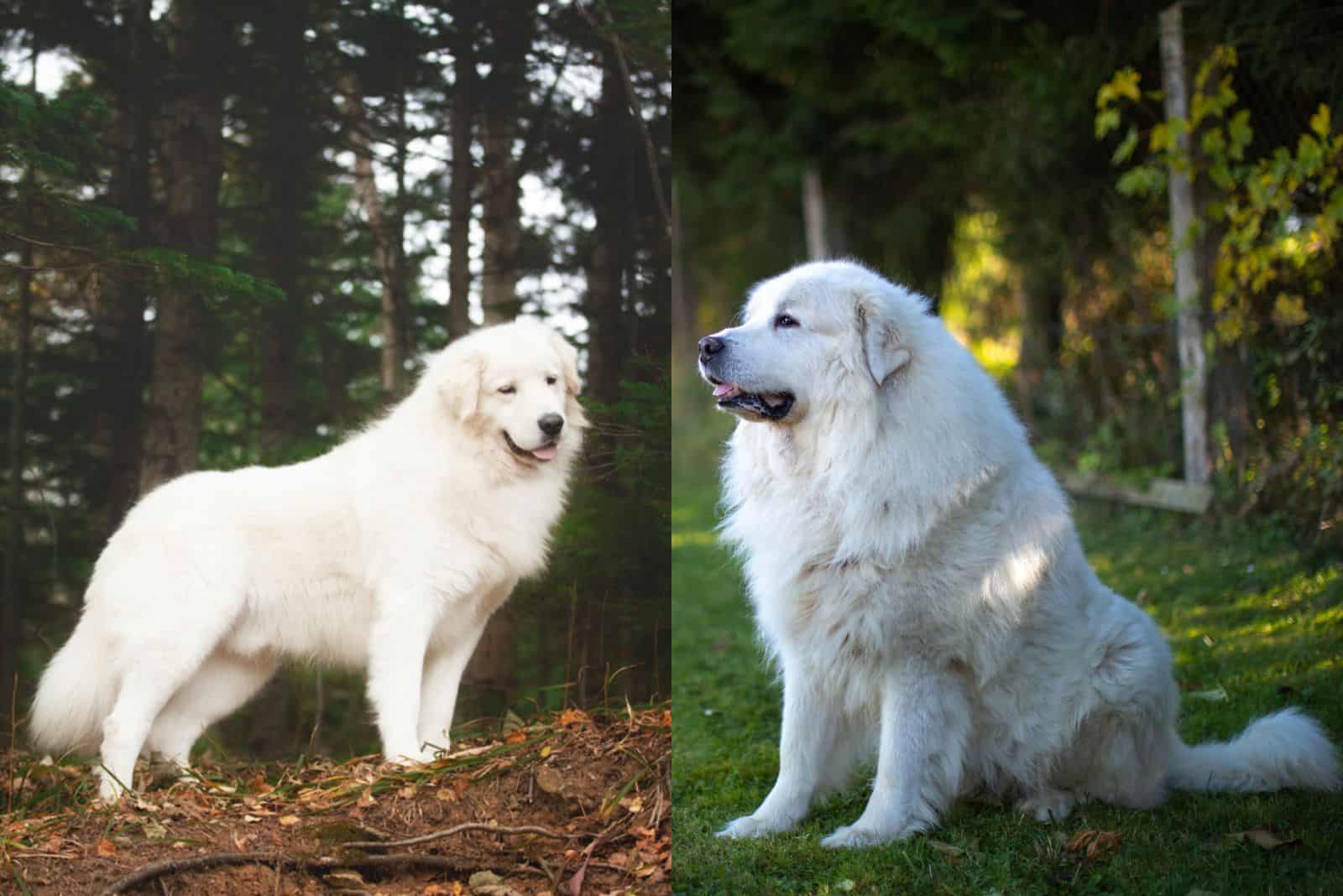A prime example is the similarity in appearance between the Great Pyrenees as well as the Maremma Sheepdog, both of which were bred as guard dogs, and have huge, dense, white fur. So, Maremma Sheepdog Vs Great Pyrenees: what are the differences?
Are the Great Pyrenees and the Maremma similar? The Great Pyrenees and the Maremma Sheepdog are entirely separate breeds.
Maremma dogs were created in Italy, but the AKC has not yet approved them. Although they are a little bit smaller, and possess a harsher coat than Pyrenees Mountain Dogs, their appearance, demeanor, and abilities are remarkably similar.
Are you attempting to choose between getting a Great Pyrenees or a Maremma Sheepdog? In order to determine which dog is best for your needs and your living, let’s examine their significant similarities and differences in more detail.
Let’s Compare Them: Maremma Sheepdog Vs Great Pyrenees
At first look, it can be challenging to distinguish between the Maremma Sheepdog and the Great Pyrenees. To facilitate a comparison, we’ve listed some of their main distinctions separately below.
[table id=731 /]
Read more about: The Great Pyrenees growth chart
Maremma Sheepdog Vs Great Pyrenees Origin
The traditional sheepdog breed, known as the Maremma, originates in the Maremma province of Italy. They were initially developed to protect sheep flocks from bear and wolf attacks.
Both of these dog breeds were bred for a similar cause. Both of them were bred to be good watchdogs, and even better herding dogs.
These days, they make wonderful family pets and watchdogs. They are devoted, obedient, and kind to kids. Maremma dogs may not be the greatest choice for novice dog owners because they are also renowned for being quite independent and stubborn.
Huge, cuddly dogs like the Great Pyrenees can make wonderful family pets. They were initially developed in the Pyrenees Mountain Range to guard sheep from wild animals and other enemies.
Maremma Sheepdog Origin
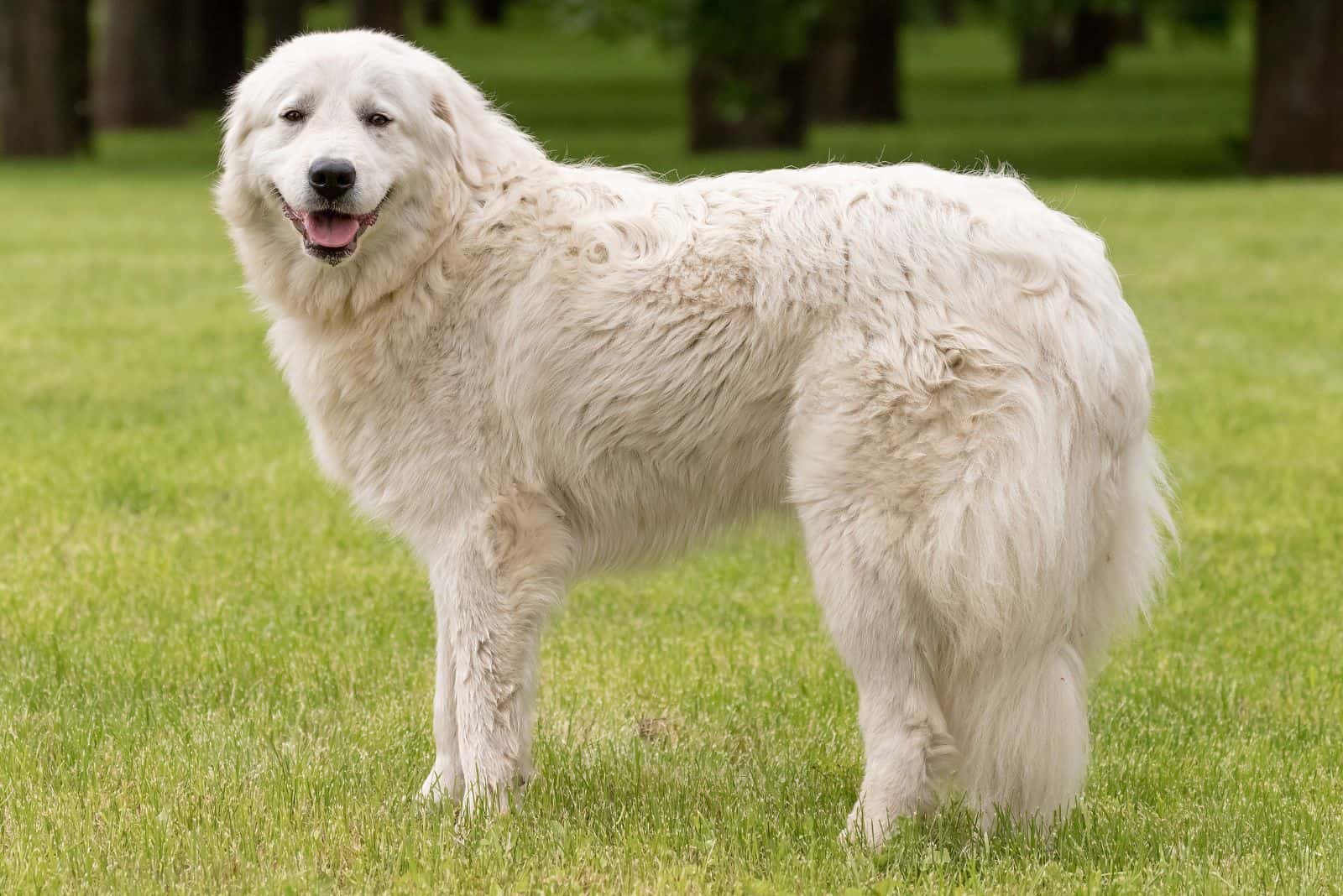
Many people have told the tale of the Maremma Sheepdog, but its origins are still a matter of debate and doubt. These dogs appear to have come from Asia, along with the migrant tribes who settled in various regions of Europe and began the most primitive form of breeding.
We might believe that the progenitors of the contemporary Maremma had already reached central and southern Italy around that period, after the Greeks, given the prevalence of white guardian dog references in Latin poetry.
The modest variations between the many breeds of white guard dogs are primarily due to various climatic and geographic conditions, as well as selection, but they nevertheless share some fundamental psycho-physical characteristics.
The Pyrenees Mountain Dog is found in France, as are the Kuvatch, the Tatra, and the Chuvack in Hungary, Romania, and the Czech Republic, among others.
The Maremma Sheepdog has been referenced by early Italian writers, and a 13th-century painting depicting a Maremma may be found in Florence’s Santa Maria church.
The initial stock originated from emigrating Eastern Shepherd dogs, which later evolved into distinct breeds unique to a single location, such as the French Pyrennean Sheepdog as well as the Hungarian Kuvasz.
According to flock movements over the changing seasons, the shorter-coated Maremmano as well as the longer-backed Abruzzese in Italy eventually fused into a single breed.
The Maremma continues to be the most widespread and well-liked sheepdog in Italy nowadays. It is reported that the intrepid Maremma will fend against predators and human enemies. The first Maremma to be exported to England was “Drago of Castelnuovo” in 1931.
The Great Pyrenees Dog Origin
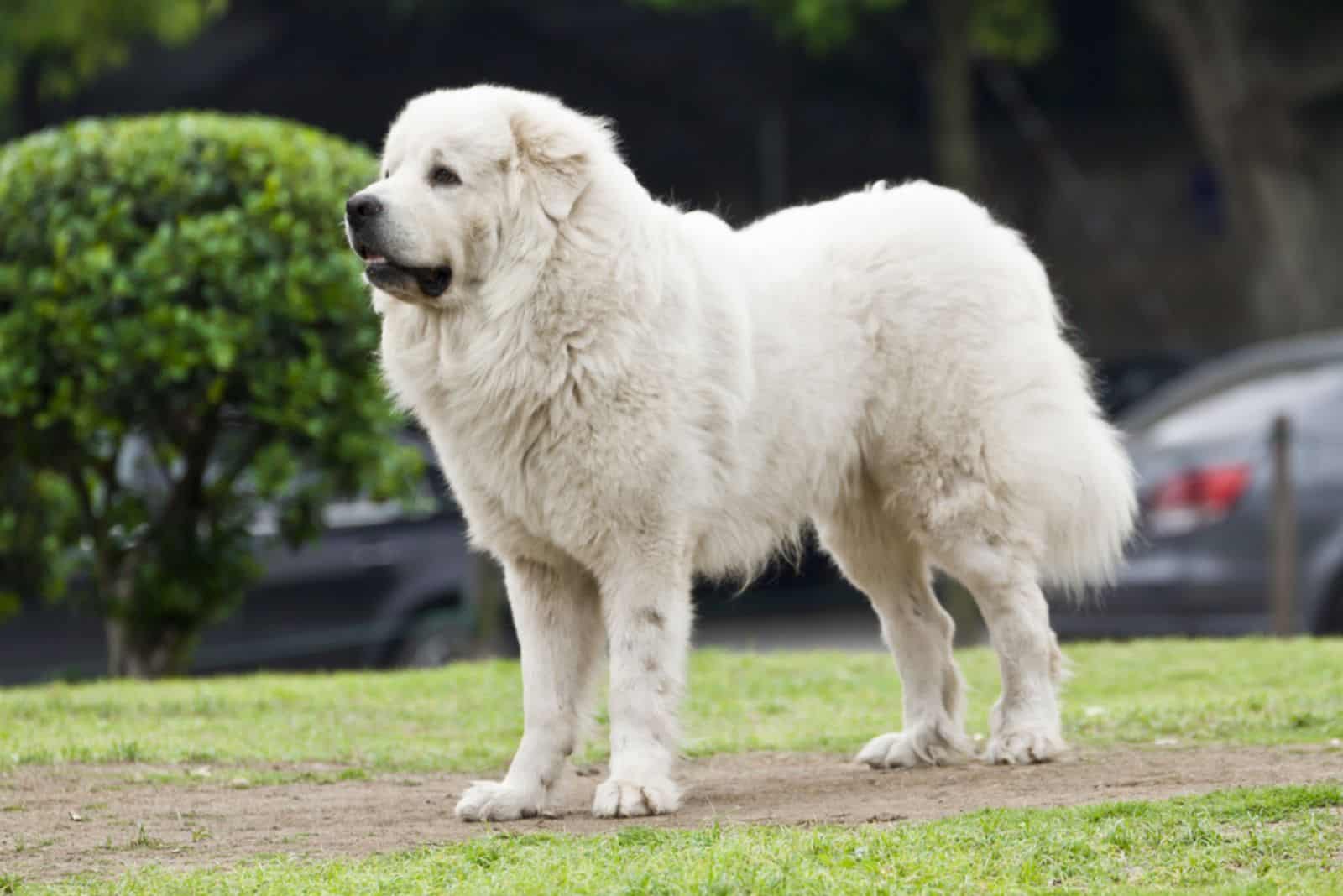
The breed most likely developed from a population of mostly white highland livestock guard dogs that were first domesticated in Asia Minor nine or ten thousand years ago.
It is extremely likely that these big white canines traveled to the Pyrenees Mountains around 3000 BC with their domesticated sheep and shepherds. There, they came into contact with the local natives, among whom were the Basques, who were descended from Cro-Magnon Man.
The breed evolved the features that set it apart from the broad group of livestock guardian dogs as well as the predominantly white members of such a group throughout these millennia amid the seclusion of the Pyrenees Mountains.
The Great Pyrenees is indeed a breed of dog used by highland shepherds. The Great Pyrenees formed a unique bond with the shepherds, their household, and the sheep over this extended period.
French records from 1407 describe how helpful these “Great Dogs of the Mountains” were in protecting the Chateau of Lourdes. The Dauphin in the royal court of Louis XIV designated them as the Royal Canine of France in 1675, and as a result, nobility started to highly prize them.
Each dog was valued at the equivalent of two men because of their sharp eyesight and sense of smell, which made them essential as shepherds, companions, and castle guards.
When not tending to the flocks, “Patou,” as he is affectionately known, can be seen lounging on the mat at the entranceway of the shepherds’ modest homes.
The Great Pyrenees received official approval from the American Kennel Club in February 1933, and from April 1933 on, the breed started receiving its own division in authorized events.
The Great Pyrenees now serves as a working dog in addition to a pet and a household dog. The majority of our dogs never step foot in a dog show; however, they are cherished and trusted family pets that sometimes serve as livestock guardians on ranches and farmlands.
Maremma Sheepdog Vs Great Pyrenees: Who Is The Bigger Boy
Without putting the Maremma Sheepdog and the Great Pyrenees side by side and carefully comparing them, it’s unlikely that you could determine which breed is larger.
Only a few inches separate these two, and all those that defy typical size restrictions may actually be of identical size.
However, based on that average measurement, the Great Pyrenees is a few inches larger than the Maremma Sheepdog. The tiniest Maremma Sheepdog measures 23 inches whereas the typical Great Pyrenees reaches 25 inches at the shoulder area.
Whenever it concerns weight, the gap is significantly more obvious because the obviously heavier Great Pyrenees weighs 50 lbs more than the Maremma Sheepdog. That discrepancy is equivalent to a tiny hay bale.
What Kind Of Temperament Do These Dogs Have?
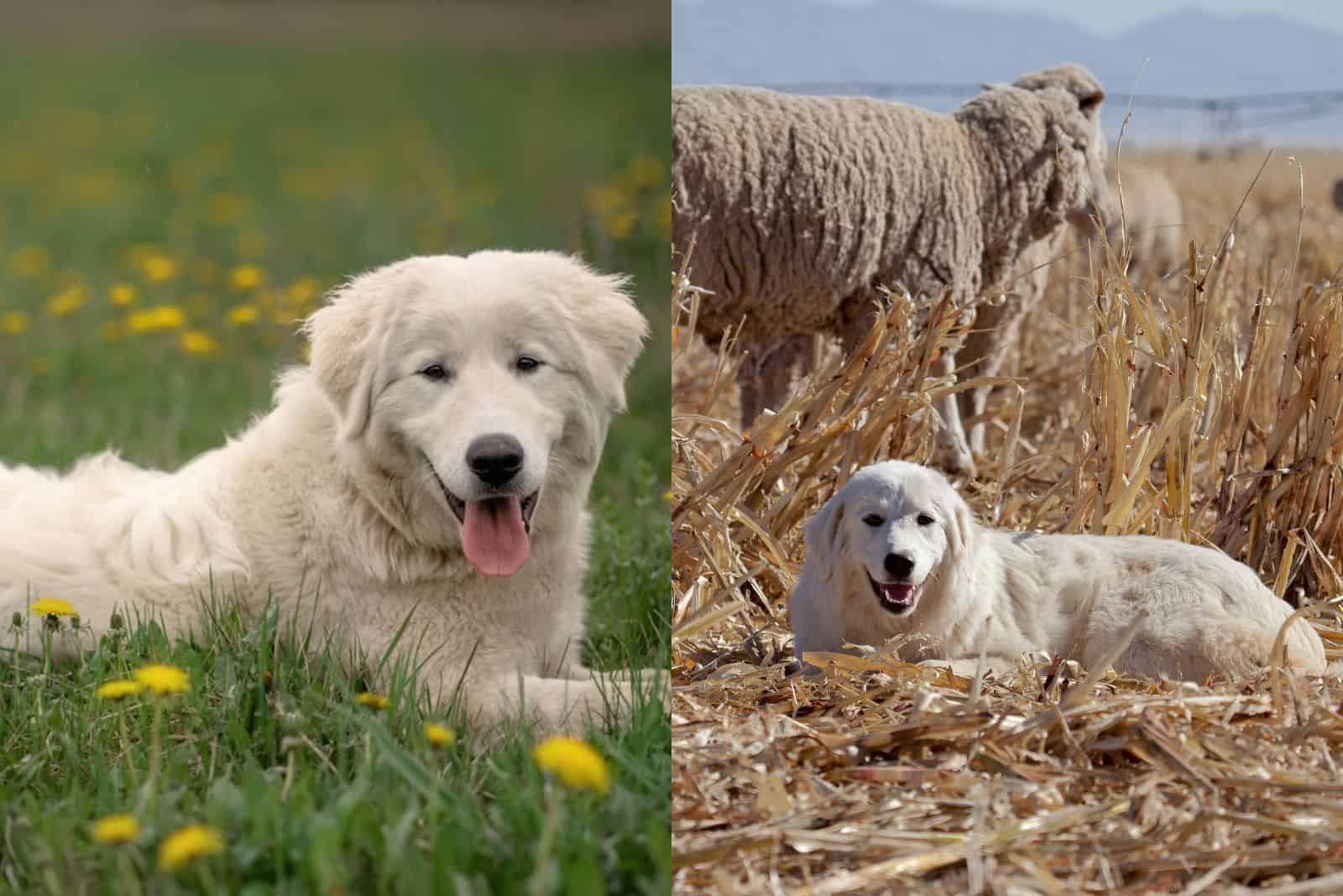
Both of these gentle giant dog breeds have been living for centuries in rough living conditions. They have been bred to be courageous and low maintenance, however, hard-working.
Those kinds of living conditions do make a recognisable mark on the temperaments of these dog breeds. They need to be a certain type of dog… in this case, they have a certain type of personality that will be strong enough and brave enough to live in such ways.
Both of these dogs have been bred to be alert whenever someone or something strange is approaching its family or property. Today, that manifests as these dogs being great guard dogs, good watchdogs, and great herding dogs.
Both of them are very warm-hearted when it comes to their owner and their human family. Take get along well with children, and make wonderful family dogs for people living in a house that has a big yard or a farm.
The temperaments of the Great Pyrenees and the Maremma Sheepdog are comparable. Both are clever, kind, and caring around family members when necessary. Both, nevertheless, are also fiercely devoted and great guardians of their family and property.
The Great Pyrenees has a propensity to be a little more independent. Due to this, they may find training a little more challenging, but it is still doable and required for a strong, happy dog.
What Is The Temperament Of Maremma Sheepdogs?
Maremma Sheepdogs are devoted to their work, and to both human and animal kin with the same loyalty. When given a ton of room to move around freely and live independently, they perform best.
Although they aren’t typically disruptive or mischievous individualists, they can adapt to your home and family with early training and socializing.
Using elder Maremma Sheepdogs to help train younger ones is a common training technique. Programs for formal obedience are also beneficial. For the best chance of obedience from your Maremma, it’s critical to establish your authority.
However, like with other dogs, you must train them without causing them harm; using harsh physical punishment is a terrible notion that will only backfire.
Due to their reputation as watchdogs, Maremmas often don’t get along well with outsiders. They can bark and physically form a barrier, but they aren’t extremely violent until something or someone is harming them or their family.
They may accept a stranger who is presented as a “friend” in the family, but they are unlikely to show them any affection or be friendly with them.
These dogs have trouble telling the difference between playfulness and potential harm when they are among strangers. They might charge in if they perceive a relative’s tickling attack on the children as being a harmful situation.
If you anticipate having visitors, it’s a fantastic strategy to have a place prepared to enclose your Maremma. They often dislike having a lot of visitors.
A farm would be the perfect setting for them as there, they could make excellent use of their innate ability to protect livestock. They enjoy putting in a lot of effort and interacting with their own family and other animals. They struggle when left alone for protracted periods of time.
What Is The Temperament Of The Great Pyrenees?
A Great Pyrenees typically exhibits a quiet, peaceful, obedient temperament. Shyness, aggression, and anxiousness are never appropriate, but while he’s a puppy, do your part by exposing him to a ton of socialization. He can become well-mannered with instruction.
He is kind, and might be a little somber.
He is intelligent, accustomed to working independently, and capable of making decisions on his own, making him an independent thinker who can be stubborn. He continues to be a pleasant, relaxed, and kind guard dog at the same time.
Just like every other breed of dog, the Great Pyrenees needs decent socialization, or else being exposed to a wide variety of people, activities, noises, and situations when he is little. The Great Pyrenees dog’s development into a well-rounded dog is facilitated through socialization.
You should start this by enrolling him in a kindergarten class for puppies. His social skills will also improve if you routinely host guests, as well as if you take him to crowded parks, pet-friendly stores, and on slow walks to encounter the neighbors.
This dog breed can live in literally any kind of weather conditions. They are extremely tough, durable, and strong dogs.
Maremma Sheepdog Vs Great Pyrenees: Which Is The Better Family Dog
There are a few factors to take into account when deciding between the Maremma versus Great Pyrenees as a family pet. The Pyrenees is indeed a big, placid breed that gets along well with kids.
They make good guards, and are very devoted to their family. Although they are a huge breed as well, the Maremma are not as peaceful as the Great Pyrenees. Although they get along well with kids, they could be too lively for very small children.
However, both of these breeds are regarded as gentle giants. This means that both of these dogs exhibit extraordinary behavior around people who are familiar to them, especially family members.
Both of them are really gentle with children, and what is more important… they are really tolerant. Most of them will let your five-year-old pull their ears, tail, or ride them as a horse.
However, sometimes they can get too playful, and thanks to their large size, they could unintentionally knock down a small child. Because of this, I recommend that you always observe any of these dogs playing with your child.
Maremma Sheepdog Vs Great Pyrenees: Let’s Talk Health
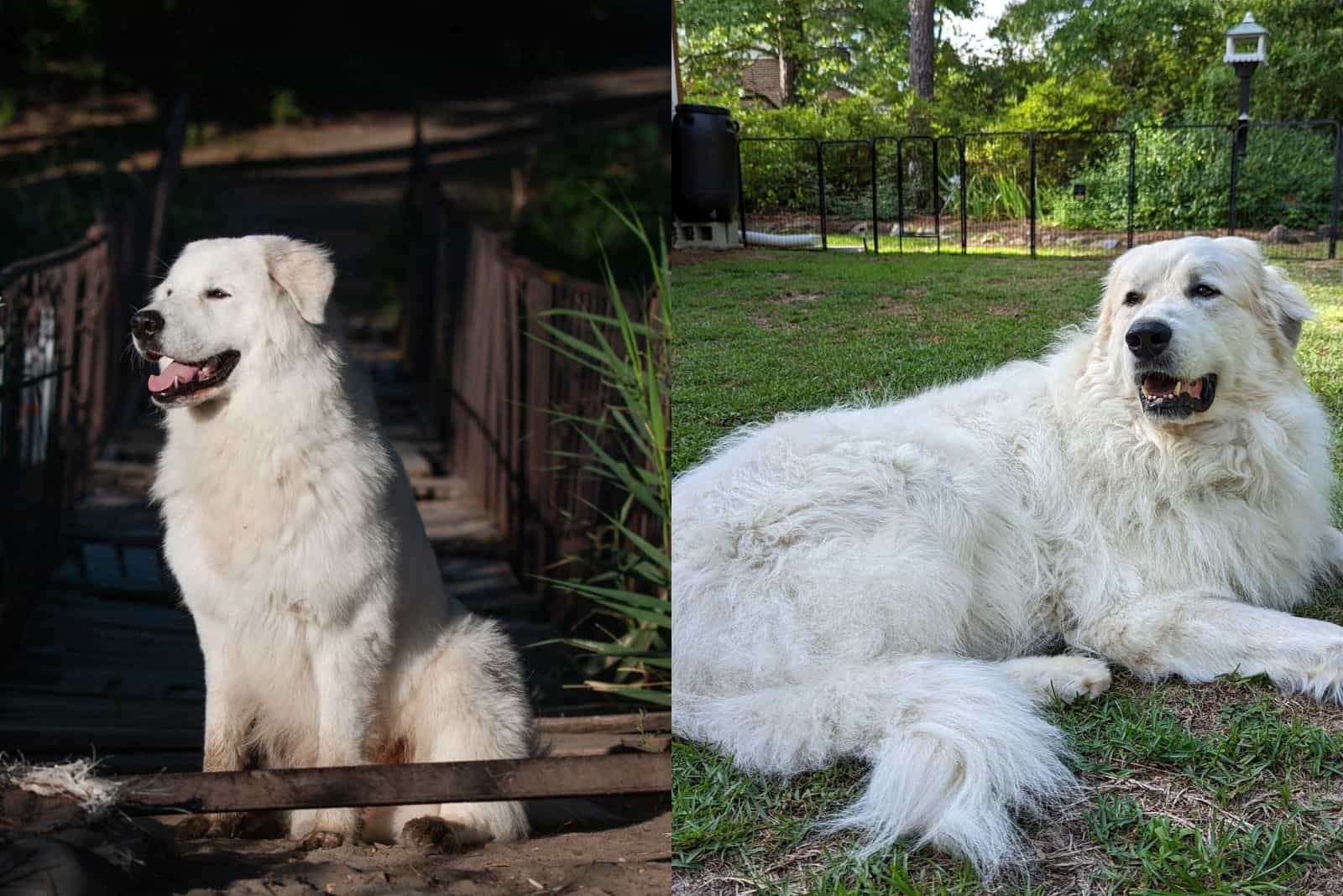
The Maremma Sheepdog breed is a dog with comparatively few health issues. However, they are prone to bloat, ear infections, and hip abnormalities.
Although the Great Pyrenean Mountain dog seems to be a breed that generally enjoys good health, they are more susceptible to conditions like certain cancers, seizures, ear problems, hip dysplasia, as well as bloat.
Therefore, I recommend learning a bit about every one of these health problems.
1. Hip Dysplasia And Elbow Dysplasia
These breeds have a background of serving as sheep guardians against wolves and bears. However, the vulnerability of these two breeds to hip dysplasia varies.
Hip dysplasia is indeed a disorder that causes pain and disability because the hip joint somehow doesn’t develop normally.
Compared to Great Pyrenees, Maremma Sheepdogs have a substantially lower risk of developing hip dysplasia. This is supposed to be because Maremma Sheepdogs, as opposed to Great Pyrenees, were bred especially for this reason.
The Maremma Sheepdogs’ genetic lines are also significantly better written than the Great Pyrenees’, making it simpler to spot and prevent health issues like hip dysplasia.
Surgery is one option for treatment, although it is a costly and uncomfortable process.
A dogs’ elbow joint development can be impacted by the disorder known as elbow dysplasia. It frequently results in limping, and therefore, might induce arthritis as the dog gets older.
The issue, which is more prevalent in some breeds, including the Great Pyrenees and the Maremma Sheepdog, is assumed to be genetic. Elbow dysplasia comes in a variety of forms with varying degrees of severity.
Surgery, pain relief, exercise limitation, and weight control are all possible treatment methods.
2. Obesity
Animals that are overweight, but then lose weight tend to live longer, have more energy, and have less pain. New therapy strategies have been found, and the condition has been better described by recent studies.
Regardless of how well-mannered your Great Pyrenees or Maremma is, repress the desire to serve them leftovers. Although it can be alluring to start giving in to those beseeching eyes, the danger is not worth it.
This is why:
First, eating table leftovers can cause obesity and excess weight since they are typically heavy in both calories and fat.
Even though a little more weight might not appear to be a huge thing, it actually increases your pet’s chance for significant health issues, including cardiovascular disease, diabetes, and joint difficulties.
Secondly, giving table leftovers to animals might result in digestive problems, including vomiting and diarrhea. It’s crucial to keep in mind that a dogs’ digestive system differs from ours, so their body might not be able to process some foods the same way we can.
Thirdly, it’s difficult to determine exactly what’s in table scraps. While certain meals are suitable for dogs, some are poisonous or even fatal. For instance, you should never offer your dog chocolate because it is fatal to pets.
If you do choose to feed your dog any table scraps, it is advisable to limit this, and pay attention to what you are giving them.
Read more about: Great Pyrenees Feeding Chart
3. Bloat
There are several signs of canine bloating, but the most typical ones are an enlarged stomach, an increase in hunger, and agitation. All dog breeds are susceptible to bloat, although giant dogs, such as the Maremma as well as the Great Pyrenees are more likely to get it.
Bloat happens whenever the abdomen swells from fluid or gasses, and presses against the diaphragm. If left untreated, this may lead to discomfort, trouble breathing, and even fatality. Take your dog to the veterinarian right away if you think it might be swollen with bloat.
Giving your dog frequent meals during the day rather than one huge meal, and minimizing activity right after eating, are just a couple of the steps you can take to minimize bloat in dogs.
Consult your veterinarian about additional preventative treatments, such as gastropexy surgery, if your dog is predisposed to bloating.
Both breeds are generally healthy, but the Maremma Sheepdog seems to be the overall winner. However, both types of dogs are often strong and have a long life.
Maremma Sheepdog Vs Great Pyrenees: Life Expectancy
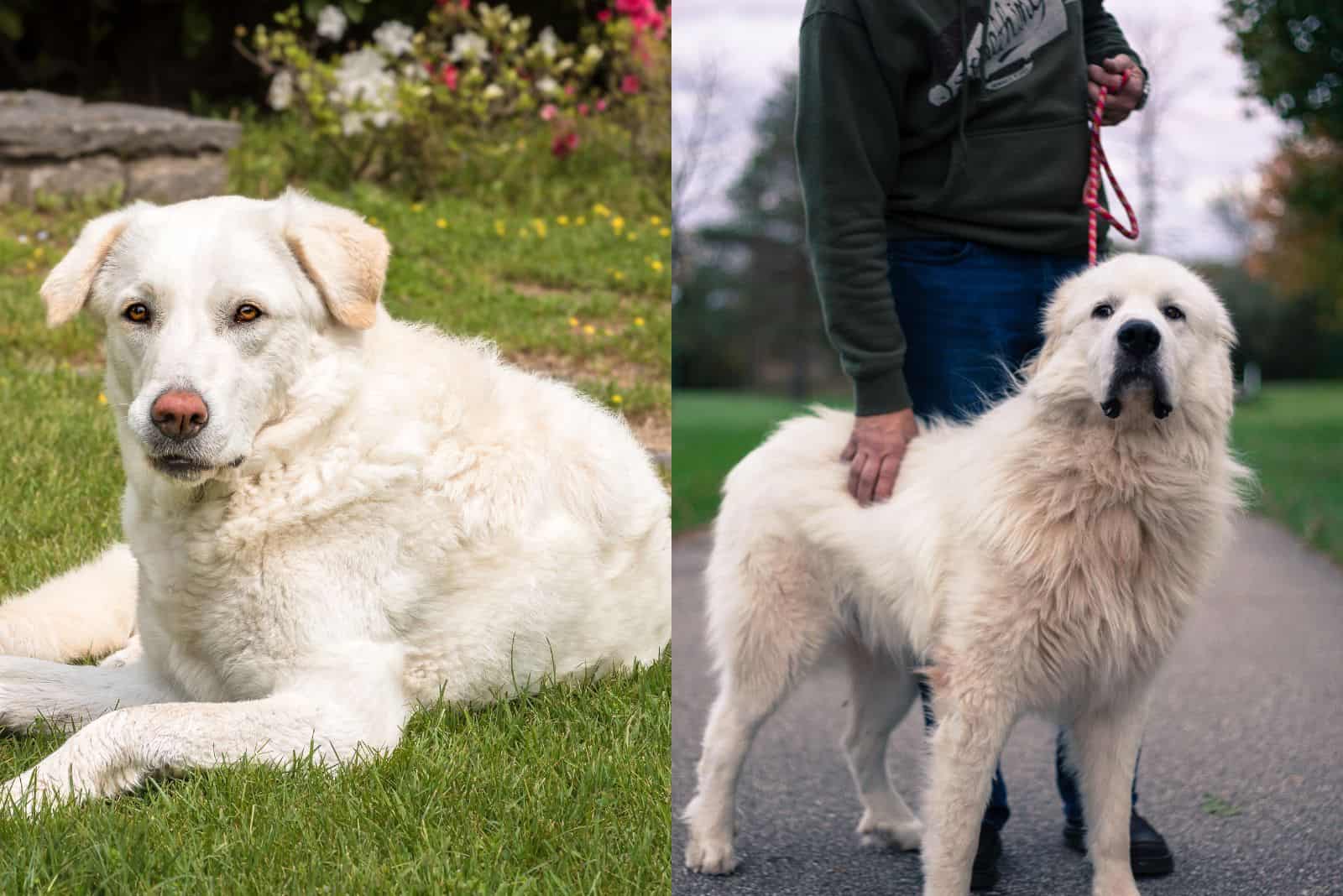
Both of these dogs have been bred to be tough, and to be healthy and sturdy enough to endure rough living conditions.
Each of these two dogs will provide you with many joyful years. Maremma Sheepdogs often remain alive for a year longer than Great Pyrenees.
Even though both dogs experience some common illnesses and conditions, the Great Pyrenees may have extra health issues that are inherited in nature.
This might be true because we have a lot more data on the Great Pyrenees since it is a dog breed that is far more common than the Maremma Sheepdog.
Being as it is, the average lifespan of the Maremma Sheepdog is 12 to 14 years of age, providing at least the average dog food, vet checks, and keeping it fit.
The average lifespan of the Great Pyrenees Mountain dog will be around 10 to 13 years of age, providing the basic necessities that this dog needs in order to be healthy.
Both of these dogs must be bought from a good and ethical breeder. They need to be well taken care of just as any other dog breed.
However, they are large dogs, which means that they will need special attention to some underlying conditions that are specific for dogs of their size.
Maremma Sheepdog Vs Great Pyrenees: Trainability Levels And Needs
Each of these dogs has a reputation for being very trainable, and they possess high intellectual capacities.
The Maremma Sheepdog as well as the Great Pyrenees are both exceptionally trainable, but this does not necessarily mean they are simple to train.
That is, unless you count the Great Pyrenees.
While the Great Pyrenees is far more autonomous and dominant than the Maremma Sheepdog, both breeds respond well to directions, and are motivated to please.
This indicates that even while they can pick up on commands quickly, they might not want to.
Regardless of their size, they require soft, positive reinforcement, and they must be trained again from the period when they are young puppies. Both of these dogs have exquisite memory, which means that if you do them wrong once, they will remember it for the rest of their life.
The Pyrenees will become timid, scared, and shy as a result of negative training, which is troublesome for any dog, much more for one of this size.
If they are not employed as farm dogs, these large-size dog breeds might become agitated, anxious, and troubling if their energy levels are not exploited in proper ways.
Being as it is, I would not recommend any of these dogs for apartment living since their heritage tells a completely different story than the one of a large, thick, double coat dog living in an apartment and simply going out to pee 3 times a day.
They need excitement, they need a daily task, and they need tiring activities to keep them content. These are not your regular couch potato dogs, but are the best dogs if you either live in a house with a big garden, on a farm, or at least if you are an active individual.
Maremma Sheepdog Vs Great Pyrenees Barking Levels
Both of these dogs enjoy having conversations with their owner as well as with any other living being. The Great Pyrenees is marginally louder than the Maremma Sheepdog when the volume is turned up, though.
However, none of these dogs fit the bill if you’re searching for a breed which either doesn’t bark at all or makes only a little noise. They are more prone to communicate with their surroundings by barking since they are intelligent natural guardians.
They were taught to be loud and to alert their owner when the slightest changes happen. Just like Kangals, Tornjaks, or any other livestock guardian dog breed, they will be alert at all times, and will do their best to make you aware of any changes ahead.
That is also one of the reasons why I don’t recommend these dogs for apartment living. Your neighbors might complain about the loud noise, and for their smell.
Expect barking at all occasions: when you come home from work, when the wind blows in an unexpected direction, when someone doesn’t give them proper attention, not to mention when somebody unfamiliar enters your (their) property, whether that someone is a human or an animal.
Maremma Sheepdog Vs Great Pyrenees: Key Differences In Looks
Great Pyrenees and Maremma Sheepdogs are two huge dogs that are regarded as farm dogs, working dogs, herding dogs, and many more.
Although they share many traits, and were developed for comparable purposes, there are additionally some significant distinctions among the two breeds.
Their thick, multilayered coat of both breeds insulates them from the harsh weather, and also provides protection against it. Maremma coats are heavy and wavy, whereas Great Pyrenees coats are lengthier and fluffier.
Although they are shaped uniquely, the Maremma and the Great Pyrenees share two common characteristics, including their immense size and puffy coat.
The rugged coat and muscular physique of Maremma Sheepdogs give them a somewhat more rugged image that appears almost polar-bear like.
Their lengthy, flowing, double coat, which protects them from the environment, is the physical characteristic that makes them most identifiable. They are not at the top of the list of the low-maintenance dog breeds when it comes to their coat.
Around their neck, they have thicker, tougher hair, which is short around their ears and face. They also have an extraordinarily fluffy tail.
Great Pyrenees have an extremely agile physique that is incredibly strong, and is covered in a dense, double coat. Around their neck, where their coat is especially thick, they have plenty more protection from predators. Depending on the dog, their fluffy coat might either be straight or wavy.
Both types of gentle giants are reserved and stubborn, although Maremmas are significantly more so than Great Pyrenees. Maremma dogs are more challenging to teach than Great Pyrenees dogs, which are already quite obedient.
How To Take Care Of Them: Maremma Sheepdog Vs Great Pyrenees
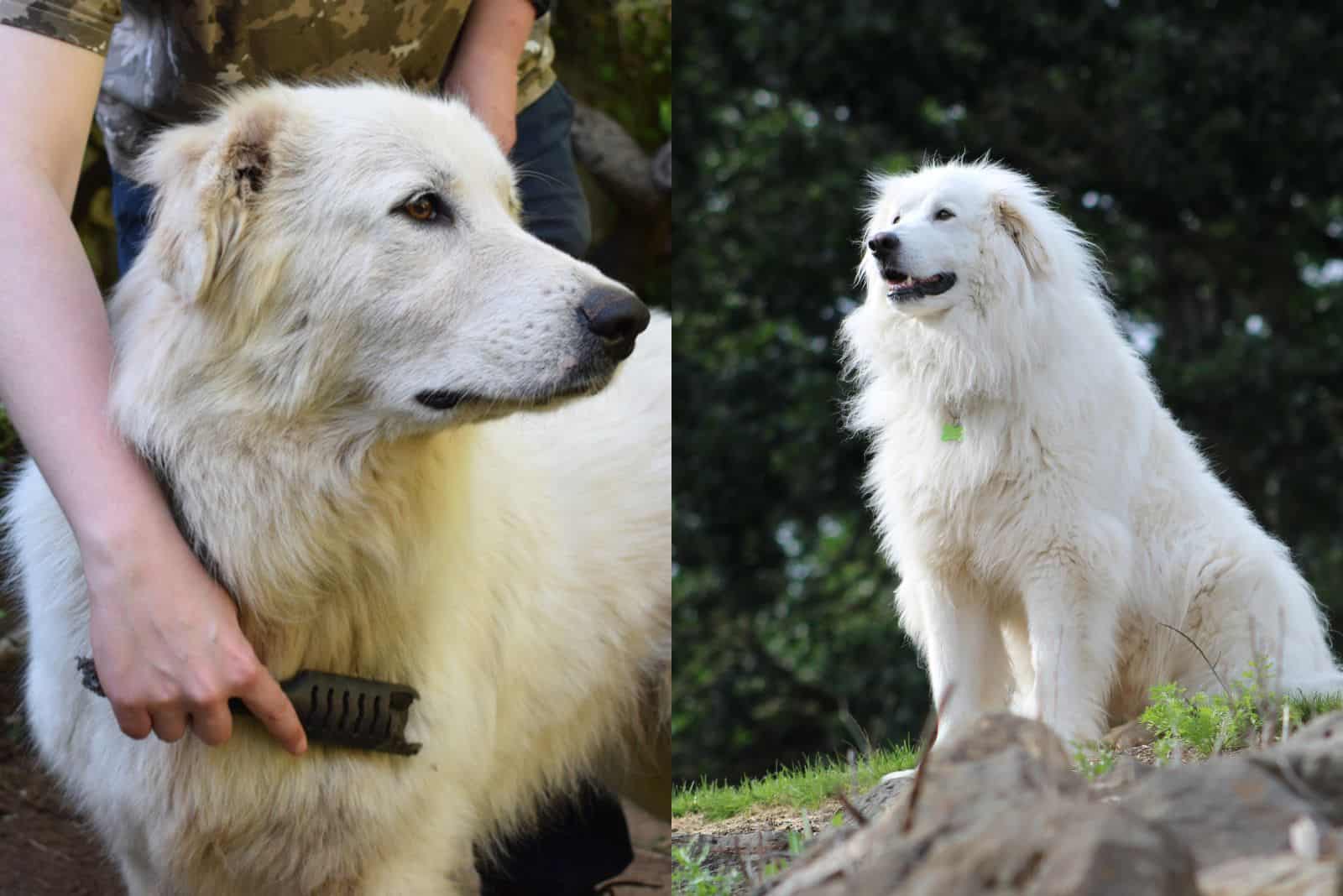
It is imperative to have a good fence surrounding your yard (which ought to be at least 4 feet in height, but ideally between five and six feet) for both the Maremma and the Pyrenees.
As a flock protector, which is accustomed to roving the Pyrenees Mountains and the Italian regions, these dogs require a territory. They will continue running to claim territory if you do not have fencing to contain them.
These large dogs have high energy levels, and they will be restless for most of the day since they need both mental and physical stimulation throughout the day.
Based on the temperature where they reside, Great Pyrenees are regarded as average to high shedders, so you may anticipate finding white hairs on clothing, home furnishings, in vehicles, and on toothbrushes.
He sheds a lot, yet despite that, he only needs around 30 minutes of grooming each week. His silk-like hair dries rapidly, and combs out easily if it gets soiled.
Even if he leaves white, fluffy dust bunnies on the carpet, if you gather them and take them outdoors, birds may use it to build nests since it provides wonderful insulation for their young.
Maremma Sheepdog Vs Great Pyrenees: Grooming Needs
Although the Great Pyrenees as well as the Maremma Sheepdog both have big, white fur, they really aren’t considered equal. The Maremma Sheepdog will function well enough with routine grooming, and it normally only has major shedding twice a year.
The Great Pyrenees, on the other hand, has a high rate of shedding, and consistently appears to leave behind white hair. Both breeds also need regular maintenance for their claws, teeth, as well as ears.
We can certainly agree upon the fact that both the Maremma Sheepdog and the Great Pyrenees need regular brushing as well as regular grooming. Both of them have a rough, double coat that sheds a lot.
However, regular brushing can minimize their shedding. You can brush them two to three times a week and save yourself the trouble. But, when the shedding season starts, you will be brushing them at least once a day!
They are not hypoallergenic dogs since they produce a lot of dander, and their sebaceous glands produce a strong smell, especially in male dogs. For those suffering from allergies that manifest as sneezing, coughing, runny nose or worse – these dogs will worsen the symptoms.
Since their ears overlap, there will be a constant need for cleaning those big fluffy ears. That isn’t anything unusual – every dog breed needs ear cleaning. However, these breeds are more prone to ear infections, so I would definitely advise ear cleaning for both of these breeds.
If your Maremma Sheepdog or your Great Pyrenees Mountain dog is a working dog, you will need to spend less time thinking about nail clipping. Dogs that are working, sighting, protecting, and herding all day will need less nail maintenance.
I would definitely put both of these breeds on the low-maintenance dog breed list since they can live in literally any living condition, and they don’t require as much upkeep as some other dogs.
Maremma Sheepdog Vs Great Pyrenees: To Socialize Or Not To Bother
There are a few important considerations when introducing your Maremma Sheepdog to new people. First off, because of this breed’s potential impatience with other creatures, earlierthan-usual socialization with other canines is crucial.
Second, if they are not properly socialized, they are naturally alert guard dogs, and will remain as such. Last, but not least, because Maremmas are highly clever dogs, and require a lot of intellectual stimulation, obedience commands and socialization are crucial for this breed.
Another breed of dog that requires adequate socializing is the Great Pyrenees. Without it, people risk them becoming distant and wary of outsiders. They are also guarding breeds by nature, so it’s important to properly train and socialize them to prevent aggression.
Let’s be clear: these dogs are not your lovey-dovey Golden Retrievers. They were not bred to retrieve stuff, and they were definitely not accustomed (as Goldens are) to be patient family dogs that live with you in your apartment.
These dogs were bred for a specific purpose. That is genetically imprinted in their bloodlines, and their initial reaction to strange events, strange people, or strange animals will either be guard mode or attack mode.
If you are buying any of these dogs to serve you as family dogs, I would warm-heartedly suggest socialization as soon as they open their eyes.
They need to meet many different people, many kinds of animals, and many kinds of noises, sights, and events in order not to react alertly to any kind of unfamiliar happening.
Mind you, this will take a lot of time and effort. If you are the type of person who wouldn’t bother doing all of these things, simply get yourself a Golden and enjoy your family pet.
Nutrition Needs: Maremma Sheepdog Vs Great Pyrenees
The Maremma Sheepdog and the Great Pyrenees Mountain dog have similar needs when it comes to dog food and daily nutrient needs.
If these dogs live an active lifestyle, prepare to spend a good amount of money on their food. If constantly active, prepare to divide around 10 cups of dog food into two meals for your Great Pyrenees, and around 6 to 8 cups of dog food for your Maremma Sheepdog a day.
And, don’t forget adding valuable supplements and additional nutrients for your dogs, which don’t necessarily come in all dog food brands.
For large dogs, especially those suffering from hip dysplasia and bloat, I recommend adding omega 3 fatty acid supplements, as well as pumpkin purée, and incorporating raw-meat meals two or three times a week, at least.
They will also benefit if you add antioxidants to their meals, such as strawberries, blueberries, or raspberries.
Both of these dogs will benefit from these kinds of meals. If you feed your dog right, its lifespan will be prolonged, and it will be and feel healthier.
Final Word
The battle known as Maremma Sheepdog vs Great Pyrenees is a close one, with a score of 1:1 – they are both equally great dogs.
The historic farm dog breed, known as the Maremma, originates in the Maremma province of Italy. These were initially developed to protect sheep flocks from bear and wolf attacks.
These days, they make wonderful family pets and watchdogs. They are devoted, obedient, and kind to kids. Maremma dogs might not be the greatest choice for novice dog owners because they are also renowned for being quite autonomous and stubborn.
Large, cuddly dogs like the Great Pyrenees can make wonderful family pets. They were initially developed in the Pyrenees Mountains to guard sheep from wolves and other carnivores.
The Maremma Sheepdog as well as the Great Pyrenees represent two dog breeds that are highly similar to one another, irrespective of whether it is in terms of look, temperament, or other fundamental characteristics.
The distinction, though, is created through the smallest details. The Great Pyrenees, for example, may shed more hair than the Maremma Sheepdog despite having a similar coat. There are also small size variations based on both height and weight.
While both can be ideal for a household that is ready to satisfy their demands, individuals wishing for less cleaning and easier training might prefer the Maremma Sheepdog.
